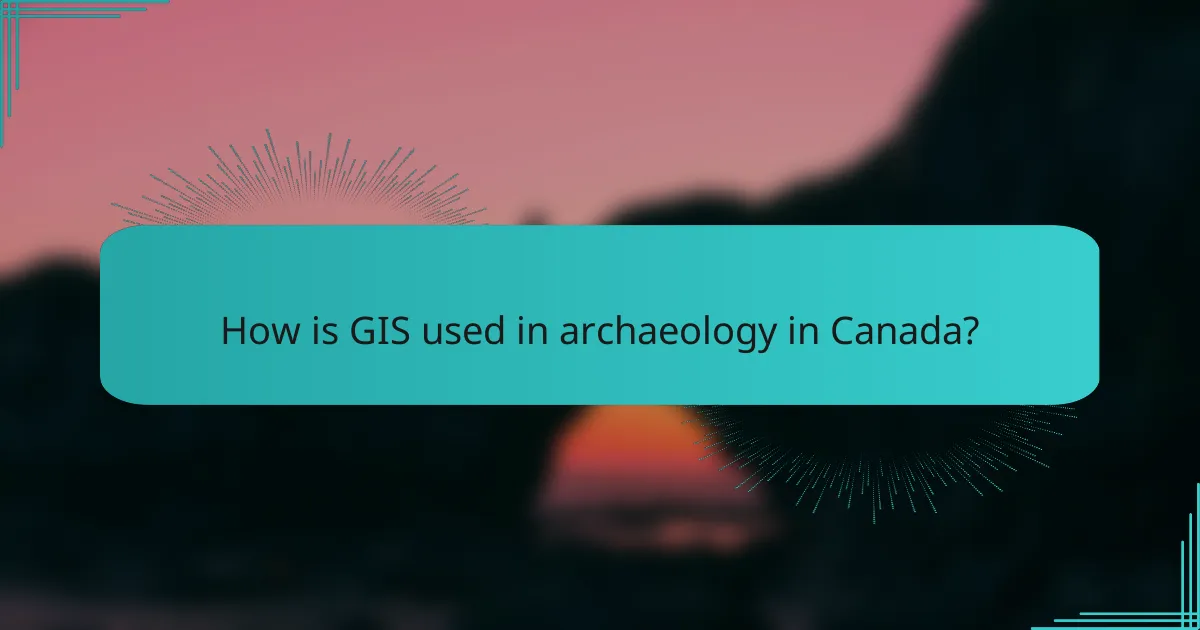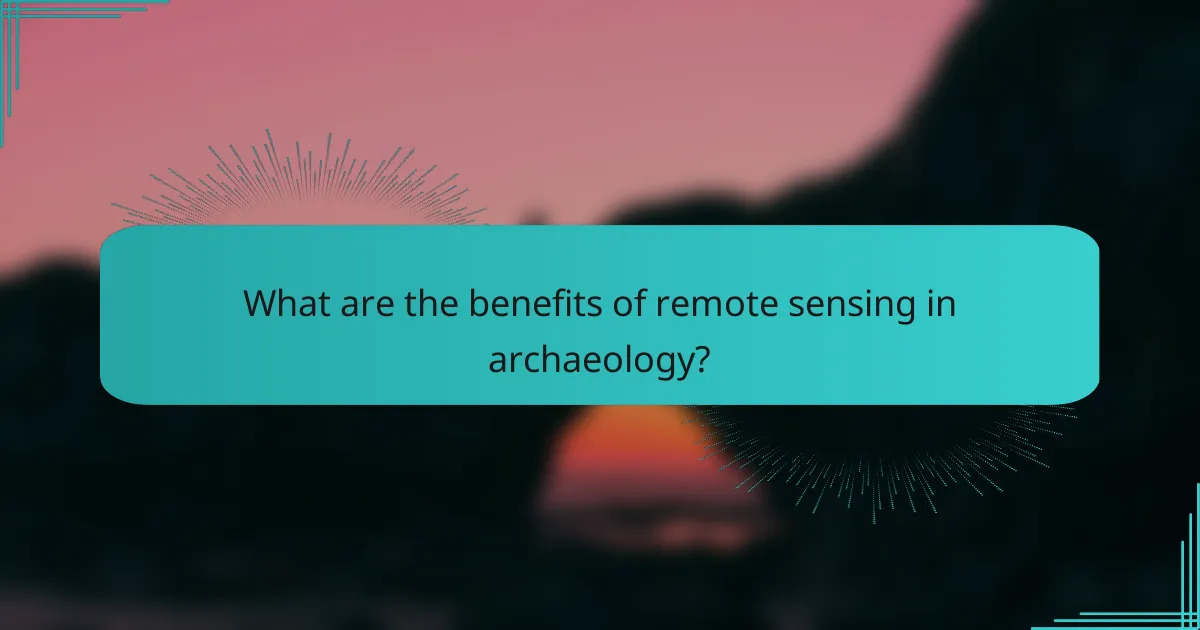Technology plays a pivotal role in archaeology, particularly through the use of Geographic Information Systems (GIS) and remote sensing. These tools allow researchers to map and analyze archaeological sites with precision, enhancing site discovery and preservation efforts. Additionally, advanced data analysis techniques enable archaeologists to extract meaningful insights from extensive datasets, leading to a deeper understanding of past human behaviors and cultural developments.

How is GIS used in archaeology in Canada?
GIS, or Geographic Information Systems, is utilized in Canadian archaeology to map, analyze, and manage archaeological sites effectively. It enables researchers to visualize spatial data, facilitating better decision-making and preservation of cultural heritage.
Mapping archaeological sites
Mapping archaeological sites with GIS involves creating detailed digital representations of locations where artifacts and structures are found. This process allows archaeologists to record site boundaries, topography, and environmental features that may influence human activity.
In Canada, GIS mapping can include layers for historical land use, vegetation cover, and proximity to water sources, which are crucial for understanding settlement patterns. Tools like ArcGIS and QGIS are commonly used for this purpose.
Analyzing spatial relationships
GIS enables the analysis of spatial relationships between different archaeological sites, helping to identify patterns and trends. By examining the distribution of artifacts and features, researchers can infer social, economic, and environmental interactions among past populations.
For example, spatial analysis might reveal clusters of sites near rivers, indicating trade routes or resource availability. Techniques such as buffer analysis and spatial statistics are often employed to quantify these relationships.
Integrating historical data
Integrating historical data into GIS allows archaeologists to enrich their analysis with contextual information. This can include historical maps, land surveys, and archival documents that provide insight into past human activities and land use.
In Canada, combining this data with GIS can help identify changes in land use over time, guiding preservation efforts. It is essential to ensure that the historical data is accurate and compatible with the GIS framework to maximize its utility.

What are the benefits of remote sensing in archaeology?
Remote sensing offers significant advantages in archaeology by allowing researchers to gather data about sites without disturbing them. This technology enhances site discovery, monitors environmental changes, and improves documentation, making it an essential tool in modern archaeological practices.
Non-invasive site discovery
Remote sensing techniques, such as aerial photography and satellite imagery, enable archaeologists to identify potential sites without excavation. These methods can reveal patterns and anomalies in the landscape that indicate human activity, such as structures or roads.
For instance, LiDAR (Light Detection and Ranging) can penetrate vegetation, allowing researchers to map ancient settlements hidden beneath tree canopies. This non-invasive approach saves time and resources while preserving the integrity of archaeological sites.
Monitoring environmental changes
Remote sensing is crucial for tracking environmental changes that may impact archaeological sites. By analyzing satellite data over time, archaeologists can observe shifts in land use, vegetation cover, and climate conditions that affect site preservation.
For example, monitoring coastal erosion through remote sensing can help identify threats to submerged archaeological sites. Understanding these changes allows for better planning and management of heritage resources.
Enhancing site documentation
Remote sensing technologies improve the accuracy and detail of site documentation. High-resolution images and 3D models generated from remote sensing data provide comprehensive records of archaeological features, which can be invaluable for research and education.
Additionally, integrating remote sensing data with Geographic Information Systems (GIS) allows for sophisticated spatial analysis. This combination enables archaeologists to visualize relationships between sites and their environments, enhancing overall understanding of historical contexts.

How does data analysis improve archaeological research?
Data analysis enhances archaeological research by enabling researchers to uncover insights from large datasets, leading to more informed conclusions about past human behavior. By applying various analytical techniques, archaeologists can identify trends, make predictions, and visualize complex information effectively.
Identifying patterns in artifacts
Identifying patterns in artifacts involves analyzing the distribution and characteristics of items found at archaeological sites. Techniques such as cluster analysis can reveal spatial relationships and help determine how artifacts were used or traded. For example, a concentration of pottery shards in a specific area may indicate a communal cooking site.
Researchers often use software tools to categorize artifacts based on attributes like material, age, and style. This systematic approach allows for the identification of cultural trends over time, which can provide insights into social structures and interactions among different groups.
Predictive modeling for site location
Predictive modeling uses statistical methods to forecast potential archaeological site locations based on environmental and cultural factors. By analyzing variables such as topography, proximity to water sources, and historical land use, archaeologists can create models that suggest where undiscovered sites might be located.
For instance, a model might indicate a high likelihood of finding ancient settlements near riverbanks, guiding field surveys and excavations. This targeted approach can save time and resources, making archaeological investigations more efficient.
Data visualization techniques
Data visualization techniques transform complex data sets into visual formats that are easier to interpret. Tools like Geographic Information Systems (GIS) allow archaeologists to create maps that display artifact distributions, site locations, and environmental changes over time.
Effective visualizations can highlight trends and anomalies that might not be apparent in raw data. For example, heat maps can show areas of high artifact density, helping researchers prioritize excavation efforts. Utilizing clear and informative visuals enhances communication of findings to both academic and public audiences.

What technologies support GIS applications in archaeology?
GIS applications in archaeology are supported by various technologies that enhance spatial analysis, mapping, and data interpretation. Key tools include specialized software like ArcGIS and QGIS, as well as advanced remote sensing techniques such as LiDAR, which collectively improve the understanding of archaeological landscapes.
ArcGIS for spatial analysis
ArcGIS is a powerful software suite widely used for spatial analysis in archaeology. It allows researchers to create detailed maps and analyze spatial relationships between archaeological sites. Users can leverage its extensive tools for geostatistical analysis, modeling, and data visualization to uncover patterns that may not be immediately apparent.
When using ArcGIS, it’s essential to ensure data accuracy and proper layering of geographic information. Common pitfalls include neglecting to update data sources or misinterpreting spatial relationships. Familiarizing oneself with the software’s capabilities can significantly enhance research outcomes.
QGIS for open-source mapping
QGIS is an open-source alternative to proprietary GIS software, making it accessible for archaeologists with limited budgets. It offers robust mapping capabilities and supports a wide range of data formats. QGIS is particularly useful for collaborative projects, as it allows multiple users to contribute to the same dataset without licensing concerns.
To maximize QGIS’s potential, users should take advantage of its plugins, which can extend functionality for specific archaeological needs. Regularly updating the software and engaging with the QGIS community can provide valuable insights and support for troubleshooting.
LiDAR for landscape analysis
LiDAR (Light Detection and Ranging) is a remote sensing technology that generates precise, three-dimensional information about the Earth’s surface. In archaeology, LiDAR is invaluable for identifying subtle topographical features that may indicate buried structures or ancient landscapes. This technology can cover large areas quickly and is particularly effective in dense vegetation.
When incorporating LiDAR data, it’s crucial to understand the resolution and accuracy of the scans. Users should also consider combining LiDAR with other data sources, such as aerial imagery, to enhance analysis. Proper training in LiDAR interpretation can lead to significant discoveries in archaeological research.

What are the prerequisites for using remote sensing in archaeology?
To effectively use remote sensing in archaeology, practitioners need a solid understanding of satellite imagery, training in data interpretation, and access to relevant software. These prerequisites ensure accurate analysis and application of remote sensing data in archaeological contexts.
Understanding satellite imagery
Understanding satellite imagery involves recognizing different types of images and their applications in archaeology. High-resolution images can reveal surface features, while multispectral images help identify materials and vegetation patterns. Familiarity with platforms like Landsat or Sentinel can enhance archaeological surveys.
Archaeologists should learn to interpret various spectral bands, as they can indicate soil composition or vegetation health, which may signal underlying archaeological features. Training in this area can significantly improve the effectiveness of remote sensing projects.
Training in data interpretation
Training in data interpretation is crucial for making sense of the data obtained from remote sensing technologies. This training typically covers analytical techniques, such as image classification and change detection, which help identify archaeological sites and assess their condition over time.
Workshops or online courses can provide practical experience with case studies, allowing archaeologists to practice interpreting real-world data. Collaborating with experts in remote sensing can also enhance skills and ensure accurate results.
Access to relevant software
Access to relevant software is essential for processing and analyzing remote sensing data. Popular tools include GIS software like ArcGIS or QGIS, which allow users to visualize and manipulate spatial data effectively. Familiarity with these programs can streamline the analysis process.
Additionally, specialized remote sensing software, such as ENVI or ERDAS IMAGINE, can provide advanced capabilities for image processing. Ensuring access to these tools, along with adequate training, can significantly improve the quality of archaeological research using remote sensing.

How do archaeologists choose the right data analysis tools?
Archaeologists select data analysis tools based on their specific project needs, the types of data being analyzed, and the capabilities of available software. Key considerations include functionality, ease of use, and compatibility with existing data formats.
Evaluating software capabilities
When evaluating software capabilities, archaeologists should assess the tools’ ability to handle various data types, such as GIS data, remote sensing imagery, and statistical analysis. Compatibility with existing datasets and the ability to integrate with other software systems are also crucial factors.
Archaeologists often look for features like spatial analysis, visualization options, and user support. For instance, tools that offer robust mapping functionalities or advanced statistical modeling can significantly enhance project outcomes.
It’s beneficial to create a checklist of essential features before selecting software. Consider aspects like user interface, processing speed, and the availability of tutorials or community support to ensure a smooth workflow.


